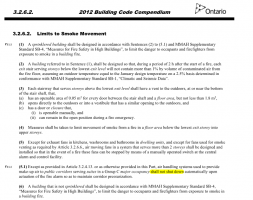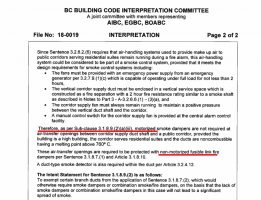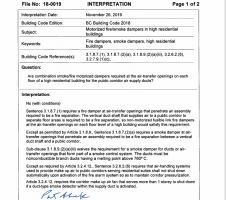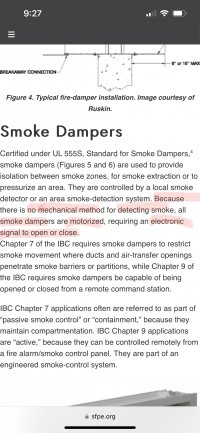-
Welcome to The Building Code Forum
Your premier resource for building code knowledge.
This forum remains free to the public thanks to the generous support of our Sawhorse Members and Corporate Sponsors. Their contributions help keep this community thriving and accessible.
Want enhanced access to expert discussions and exclusive features? Learn more about the benefits here.
Ready to upgrade? Log in and upgrade now.
You are using an out of date browser. It may not display this or other websites correctly.
You should upgrade or use an alternative browser.
You should upgrade or use an alternative browser.
Motorized fire damper vs fire dampers with fusible link
- Thread starter sunyaer
- Start date
Yankee Chronicler
SAWHORSE
This is the second page of the attached file. I can't figure out why it says that motorized smoke dampers are not required? When the code mentions smoke dampers, does it refer to motorized smoke dampers?
"Smoke dampers" refers to smoke dampers, not necessarily motorized smoke dampers. In general, motorized smoke dampers are preferred where access for resetting after deployment is difficult, or in locations where frequent testing may be called for. Obviously, a fusible link is a one-time item. Once the link melts and the damper closes, the only way to reset the damper is to open an access door, manually reset the damper, and replace the fusible link with a new link of the correct temperature rating.
Motorized dampers eliminate all that fuss and bother, and if the damper is in a location that's difficult or impossible to access, a motorized damper is the only game in town. But if a code section just says "smoke damper," either a fusible link damper or a motorized damper can be used.
Msradell
SAWHORSE
The big advantage of dampers with fusible links however is that they are definitely failsafe. Motorized dampers can and do fail in some situations. The only way a fusible link damper is going to fail is if something blocks its closing.
How can the fusible link of a smoke damper detect smoke?…But if a code section just says "smoke damper," either a fusible link damper or a motorized damper can be used.
Attachments
Yankee Chronicler
SAWHORSE
How can the fusible link of a smoke damper detect smoke?
:doh:
Took too many stupid pills this morning. Me go now.
tmurray
SAWHORSE
Yes, all smoke dampers are motorized.
What that is referring to is certain smoke control systems in high rise buildings.
Normally, smoke or combination smoke/fire dampers need to close based on a signal from an adjacent smoke detector. However, if the duct is part of the smoke control system, like pressurizing a space to prevent smoke from contaminating it, even if there is smoke in the space, we need the duct to remain open to minimize its ingress into the space. But these ducts are still penetrations in the fire separation that need to be protected from fire, so a fusible link damper would be required to ensure it operates when exposed to fire.
What that is referring to is certain smoke control systems in high rise buildings.
Normally, smoke or combination smoke/fire dampers need to close based on a signal from an adjacent smoke detector. However, if the duct is part of the smoke control system, like pressurizing a space to prevent smoke from contaminating it, even if there is smoke in the space, we need the duct to remain open to minimize its ingress into the space. But these ducts are still penetrations in the fire separation that need to be protected from fire, so a fusible link damper would be required to ensure it operates when exposed to fire.
Mac Moonfire
SAWHORSE
This is inappropriate. keep it positive eh. May I propose you offer apologies, or are you too proud?:doh:
Took too many stupid pills this morning. Me go now.
smoke dampers will be actuated by a smoke detector nearby or in some cases by the fire alarm. The fire alarm system has the means to shut smoke dampers by zones or throughout depending on the fire fighting strategy. @tmurray has offered a good explaination.How can the fusible link of a smoke damper detect smoke?
This is one of the areas of the code that is the most underexplained and outdated.
The chief plumbing/building inspector at the city of victoria gave us a webinar last year. attached is the pdf. PM me if you want the recording.
Attachments
Yikes
SAWHORSE
Mac, YCC was self-effacing, I think his ‘doh’ comment was directed at himself and his own later realization that the subject was smoke dampers, not fire dampers.
I would not be surprised if someone has already invented some kind of spring-loaded smoke damper on a magnetic hold-open that get gets actuated by a smoke detector. However, I don’t see it as practical - - it would need to be manually reset every time the detector is tested or actuated - - too much labor.
I would not be surprised if someone has already invented some kind of spring-loaded smoke damper on a magnetic hold-open that get gets actuated by a smoke detector. However, I don’t see it as practical - - it would need to be manually reset every time the detector is tested or actuated - - too much labor.
Mac Moonfire
SAWHORSE
Well in that case I'm the one who should apologise for not reading the room right. Darn it, I'm being humbled again.Mac, YCC was self-effacing, I think his ‘doh’ comment was directed at himself and his own later realization that the subject was smoke dampers, not fire dampers.
I would not be surprised if someone has already invented some kind of spring-loaded smoke damper on a magnetic hold-open that get gets actuated by a smoke detector. However, I don’t see it as practical - - it would need to be manually reset every time the detector is tested or actuated - - too much labor.
I'm not a damper expert, but i believe fusible links are spring loaded. Let us know if you find a good resourse out there about dampers, web site, or sales rep. whatever.
thanks
There are two locations in the code where there are opposite requirements (shut-down and not shut-down).This is inappropriate. keep it positive eh. May I propose you offer apologies, or are you too proud?
smoke dampers will be actuated by a smoke detector nearby or in some cases by the fire alarm. The fire alarm system has the means to shut smoke dampers by zones or throughout depending on the fire fighting strategy. @tmurray has offered a good explaination.
This is one of the areas of the code that is the most underexplained and outdated.
The chief plumbing/building inspector at the city of victoria gave us a webinar last year. ....
This was discussed (the screenshots are from Ontario Building Code, which may be different than NBCC or building codes in other provinces:

This is the opposite requirement which requires the air supply shall not be shut down:

Yankee Chronicler
SAWHORSE
Mac, YCC was self-effacing, I think his ‘doh’ comment was directed at himself and his own later realization that the subject was smoke dampers, not fire dampers.
Correct. Thank you for recognizing that.
Inspector Gadget
REGISTERED
Yes, all smoke dampers are motorized.
What that is referring to is certain smoke control systems in high rise buildings.
Normally, smoke or combination smoke/fire dampers need to close based on a signal from an adjacent smoke detector. However, if the duct is part of the smoke control system, like pressurizing a space to prevent smoke from contaminating it, even if there is smoke in the space, we need the duct to remain open to minimize its ingress into the space. But these ducts are still penetrations in the fire separation that need to be protected from fire, so a fusible link damper would be required to ensure it operates when exposed to fire.
To add to this: the critical issue involves exit shafts in tall buildings. There is a risk of "stack effect" pressures drawing smoke into an exit shaft; hence the exit shafts are required to be pressurized by forced-air ventilation. Big discussion in the NBC appendix on this.




